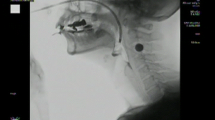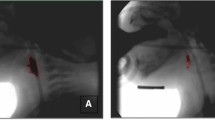Abstract
The purpose of this study was to investigate the mechanisms of aspiration with respect to the viscosity of ingested material in patients with dysphagia. Seventy patients with dysphagia underwent videofluoroscopic swallow studies (VFSS) between May 1, 2009 and September 30, 2009. Based on the findings of the VFSS, patients were divided into three groups: a thick-fluid aspiration group, a thin-fluid aspiration group, and a no-aspiration group. Kinematic analyses were performed during thick-fluid swallowing. Among our 70 patients, 23 had thick-fluid aspiration, 20 had thin-fluid aspiration, and 27 had no aspiration. A shortened duration of upper esophageal sphincter (UES) opening, a shorter interval between UES opening and peak pharyngeal constriction, and a diminished extent of laryngeal elevation were all significant risk factors for thick-fluid aspiration. A prolonged latency of the swallowing reflex, pharyngeal transit time, and the interval between bolus arrival at the vallecula and laryngeal elevation were all significant risk factors for thin-fluid aspiration. Our kinematic analysis of dysphagia employing the VFSS indicated that the mechanisms relevant to aspiration differed with respect to food viscosity.

Similar content being viewed by others

References
Kendall KA, McKenzie S, Leonard RJ, Goncalves MI, Walker A. Timing of events in normal swallowing: a videofluoroscopic study. Dysphagia. 2000;15:74–83.
Kendall KA, Leonard RJ, McKenzie SW. Accommodation to changes in bolus viscosity in normal deglutition: a videofluoroscopic study. Ann Otol Rhinol Laryngol. 2001;110:1059–65.
Palmer JB, Tanaka E, Ensrud E. Motions of the posterior pharyngeal wall in human swallowing: a quantitative videofluorographic study. Arch Phys Med Rehabil. 2000;81:1520–6.
Kendall KA, McKenzie SW, Leonard RJ, Jones CU. Timing of swallowing events after single-modality treatment of head and neck carcinomas with radiotherapy. Ann Otol Rhinol Laryngol. 2000;109:767–75.
Leonard RJ, Kendall KA, McKenzie S, Goncalves MI, Walker A. Structural displacements in normal swallowing: a videofluoroscopic study. Dysphagia. 2000;15:146–52.
The National Dysphagia Diet Task Force. The National Diet Dysphagia Diet: standardization for optimal care. Chicago, IL: American Dietetic Association; 2002.
Strowd L, Kyzima J, Pillsbury D, Valley T, Rubin B. Dysphagia dietary guidelines and the rheology of nutritional feeds and barium test feeds. Chest. 2008;133:1397–401.
Rosenbek JC, Robbins JA, Roecker EB, Coyle JL, Wood JL. A penetration-aspiration scale. Dysphagia. 1996;11:93–8.
Leonard R, Kendall K. Dysphagia assessment and treatment planning. 2nd ed. San Diego, CA: Plural Publishing, Inc.; 2008.
Rademaker AW, Pauloski BR, Logemann JA, Shanahan TK. Oropharyngeal swallow efficiency as a representative measure of swallowing function. J Speech Hear Res. 1994;37:314–25.
Kendall KA, Leonard RJ. Pharyngeal constriction in elderly dysphagic patients compared with young and elderly nondysphagic controls. Dysphagia. 2001;16:272–8.
Pauloski BR, Rademaker AW, Logemann JA, Colangelo LA. Speech and swallowing in irradiated and nonirradiated postsurgical oral cancer patients. Otolaryngol Head Neck Surg. 1998;118:616–24.
Dantas RO, Dodds WJ. Effect of bolus volume and consistency on swallow-induced submental and infrahyoid electromyographic activity. Bras J Med Biol Res. 1990;23:37–44.
Palmer JB, Rudin NJ, Lara G, Crompton AW. Coordination of mastication and swallowing. Dysphagia. 1992;7:187–200.
Donner MW, Bosma JF, Robertson DL. Anatomy and physiology of the pharynx. Gastrointest Radiol. 1985;10:196–212.
Dantas RO, Kern MK, Massey BT, Dodds WJ, Kahrilas PJ, Brasseur JG, Cook IJ, Lang IM. Effect of swallowed bolus variables on oral and pharyngeal phases of swallowing. Am J Physiol. 1990;258:G675–81.
Perlman AL, Booth BM, Grayhack JP. Videofluoroscopic predictors of aspiration in patients with oropharyngeal dysphagia. Dysphagia. 1994;9:90–5.
Johnson ER, McKenzie SW, Sievers A. Aspiration pneumonia in stroke. Arch Phys Med Rehabil. 1993;74:973–6.
Johnson ER, McKenzie SW, Rosenquist CJ, Lieberman JS, Sievers AE. Dysphagia following stroke: quantitative evaluation of pharyngeal transit times. Arch Phys Med Rehabil. 1992;73:419–23.
Bisch EM, Logemann JA, Rademaker AW, Kahrilas PJ, Lazarus CL. Pharyngeal effects of bolus volume, viscosity, and temperature in patients with dysphagia resulting from neurologic impairment and in normal subjects. J Speech Hear Res. 1994;37:1041–59.
Author information
Authors and Affiliations
Corresponding author
Rights and permissions
About this article
Cite this article
Choi, K.H., Ryu, J.S., Kim, M.Y. et al. Kinematic Analysis of Dysphagia: Significant Parameters of Aspiration Related to Bolus Viscosity. Dysphagia 26, 392–398 (2011). https://doi.org/10.1007/s00455-011-9325-5
Received:
Accepted:
Published:
Issue Date:
DOI: https://doi.org/10.1007/s00455-011-9325-5



